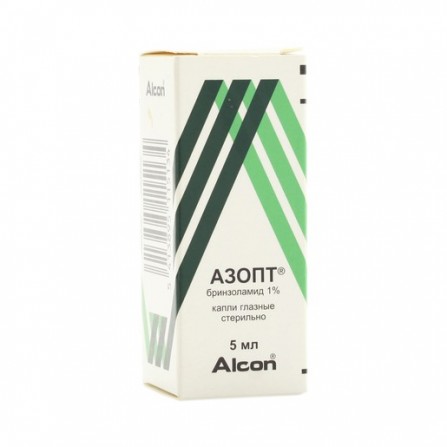More info
Active ingredients
Brinzolamide
Release form
Suspension
Composition
Eye drops 1% 1 ml: Brinzolamide 10 mg. Adjuvants: mannitol, carbomer 974P, tyloxapol, disodium edetate, sodium chloride, hydrochloric acid and / or sodium hydroxide solution (to maintain pH), purified water, benzalkonium chloride 0.01% (as preservative).
Pharmacological effect
The antiglaucoma drug is a local carbonic anhydrase inhibitor. Carboanhydrase is an enzyme present in many tissues of the body, including eye tissue. Catalyzes reversible reactions in which hydration of carbon dioxide and hydrolysis of carbonic acid occurs. In humans, carbonic anhydrase is present in the form of a number of isoenzymes, the most active of which is carbonic anhydrase II (CA-II), which is found primarily in erythrocytes and in other tissues. Inhibition of carbonic anhydrase II in the ciliary body of the eye reduces the production of intraocular fluid due to the slowing down of the formation of bicarbonate ions with a consequent decrease in sodium and fluid transport. The result is a reduction in intraocular pressure.
Pharmacokinetics
Absorption When applied topically, brinzolamide is absorbed into the systemic circulation. DistributionPlaying up with the APF is 60%. MetabolismBrynzolamide is absorbed in the erythrocytes due to selective binding to carbonic anhydrase II. accumulates in erythrocytes. Since brinzolamide and its metabolite accumulate in erythrocytes, their concentration in the blood plasma is below the limit of quantitative determination Nia (menshe10 ng / ml) .VyvedenieT1 / 2 is 111 days. Brinzolamide is excreted in the urine in unchanged form and in the form of metabolites - the main (N-deethylbrinzolamide) and small concentrations of other metabolites (N-desmethoxypropyl and O-desmethyl).
Indications
To reduce elevated intraocular pressure with: - open-angle glaucoma; - ocular hypertension.
Contraindications
- hypersensitivity to the drug.
Precautionary measures
Do not exceed recommended doses.
Use during pregnancy and lactation
Adequate and strictly controlled clinical studies of the safety of Azopt in pregnant women have not been conducted. Therefore, the use of the drug Azopt during pregnancy is possible only in the case when the intended benefit to the mother outweighs the potential risk to the fetus. It is not known whether brinzolamide is excreted in breast milk. Therefore, if necessary, the appointment of Azopt during lactation should decide on the termination of breastfeeding.
Dosage and administration
The drug is instilled in 1 drop in the conjunctival sac of the affected eye (or eyes) 2 times / day. Before use of the drug, the bottle should be shaken.
Side effects
On the part of the organ of vision: 5-10% - blurred vision; 1-5% - blepharitis, keratitis, dry eyes, hyperemia, foreign body sensation in the eye, discharge from the eyes, discomfort, pain, itchy eyes; less than 1% - conjunctivitis, keratoconjunctivitis, keratopathy, initial symptoms of blepharitis (sticking of the eyelids or crusts at the edges of the eyelids), watery eyes, diplopia, asthenopia. From the digestive system: 5-10% - bitter, sour or unusual taste in the mouth; less than 1% - dry mouth, dyspepsia, nausea, diarrhea. On the part of the respiratory system: 1-5% - rhinitis; less than 1% - shortness of breath, pharyngitis. From the cardiovascular system: less than 1% - chest pain, hypertension. From the urinary system: less than 1% - pain in the kidneys. Allergic reactions: less than 1% - urticaria. Other: 1-5% - headache, dermatitis; less than 1% - alopecia, dizziness.
Overdose
There is no data on overdose with local use of Azopt. In case of overdose caused by accidental ingestion of the drug, the following symptoms may occur: electrolyte imbalance, acidosis, nervous system disorders. Treatment: if necessary, symptomatic therapy is carried out; it is also necessary to control blood pH, electrolyte levels (especially potassium).
Interaction with other drugs
With simultaneous use of Azopt and carbonic anhydrase inhibitors for systemic use, it is possible to enhance systemic reactions associated with inhibition of the enzyme. Therefore, it is not recommended to prescribe such a combination. With the simultaneous use of Azopt and salicylates in high doses, violations of the acid-base and electrolyte balance are possible.
special instructions
With caution, Azopt should be prescribed for severely impaired liver function. Since Azopt and its metabolites are excreted in the urine, the drug is not recommended for patients with severely impaired renal function (less than 30 ml / min). Note that brinzolamide is sulfanilamide. Since it is systemically absorbed when applied topically, side reactions may develop, incl. severe allergic reactions (such as Stevens-Johnson syndrome, toxic epidermal necrolysis, hepatonecrosis, agranulocytosis, aplastic anemia). Sensitization of the body with sulfonamides may develop if the drug is re-administered with violations of instructions for its use. With the development of severe adverse reactions, the use of the drug should be discontinued. It should be borne in mind that chloride contained in Azopt benzalkonium can accumulate in contact lenses, so the lenses should be removed before instillation and installed back no earlier than 15 minutes after applying the drug. means the interval between instillation should be at least 15 min. You should not touch the eye with the tip of the dropper bottle. Use in pediatrics Effectiveness and safety The use of the drug Azopt in children has not been established. Impact on the ability to drive vehicles and control mechanisms Immediately after using Azopt, blurred vision may temporarily occur. Therefore, the patient should be careful when driving vehicles and working with equipment.





